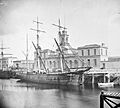Burning of Cork facts for kids
The burning of Cork (Irish: Dó Chorcaí) happened on the night of 11–12 December 1920. This event took place during the Irish War of Independence. British forces, including the Auxiliaries and Black and Tans, set fire to many parts of Cork. This was done as a punishment after the IRA attacked a British patrol in the city.
More than 40 businesses and 300 homes were destroyed. The City Hall and the Carnegie Library were also burned down. The damage cost over £3 million at the time, which is like €155 million today. About 2,000 people lost their jobs, and many became homeless.
The British government first said their forces were not responsible. But later, a military investigation found that a group of Auxiliaries caused the fires. However, no one was ever punished for the burning of Cork.
Contents
The War for Irish Independence
The Irish War of Independence started in 1919. This was after Ireland declared itself a republic and set up its own parliament, Dáil Éireann. The Irish Republican Army (IRA) fought against British forces. These forces included the British Army and the Royal Irish Constabulary (RIC).
The RIC brought in new police officers from Britain. Many of these were former soldiers from the First World War. Some joined the RIC as regular police and were called 'Black and Tans'. Others joined a new group called the Auxiliary Division. This group was set up to fight against the IRA.
The Auxiliaries and the 'Black and Tans' became known for their harsh actions. They often punished Irish civilians for IRA attacks. This included destroying property and sometimes even killing people.
County Cork was a very active place during the war. On 28 November 1920, the IRA attacked an Auxiliary patrol at Kilmichael. They killed 17 Auxiliaries. This was the biggest loss for the British in the war so far.
On 10 December, the British government declared martial law in Cork and nearby counties. This meant the military took control. A curfew was put in place for Cork city. Everyone had to be indoors by 10 pm each night. An IRA volunteer named Seán Healy said that "at least 1,000 troops would pour out of Victoria Barracks at this hour and take over complete control of the city".
The Ambush at Dillon's Cross
The IRA found out that an Auxiliary patrol usually left Victoria Barracks every night at 8 pm. They would travel to the city centre through Dillon's Cross. On 11 December, IRA commander Seán O'Donoghue learned that two lorries of Auxiliaries would be leaving. A British Army intelligence officer, Captain James Kelly, would be with them.
That evening, six IRA volunteers led by O'Donoghue waited near the barracks. Their plan was to attack the patrol and capture or kill Captain Kelly. Five volunteers hid behind a stone wall. One volunteer, Michael Kenny, stood across the road. He was dressed like a British officer. When the lorries came close, he was supposed to signal the first driver to slow down or stop. The ambush spot was only a short distance from the barracks.
At 8 pm, two lorries, each with 13 Auxiliaries, left the barracks. The first lorry slowed down when the driver saw Kenny. As it did, the IRA unit attacked with grenades and revolvers. The official British report said that 12 Auxiliaries were hurt. One of them, Spencer Chapman, died from his injuries soon after. The IRA unit escaped. Some Auxiliaries shot at them while others took the wounded to a nearby pub for safety.
The Auxiliaries then broke into the pub. They ordered everyone to put their hands up to be searched. More British soldiers and an ambulance were sent from the barracks.
The Auxiliaries were very angry about this attack. It happened so close to their base. They also wanted revenge for the deaths at Kilmichael. So, they decided to get their revenge on Cork city. An Auxiliary named Charles Schulze organized a group to burn the city centre.
The Fires and Their Impact
Over 40 businesses and 300 homes were destroyed. This covered more than five acres of the city. The total damage was worth over £3 million in 1920. The value of items stolen by British forces is not fully known. Many people lost their homes, and 2,000 people lost their jobs.
Images for kids






